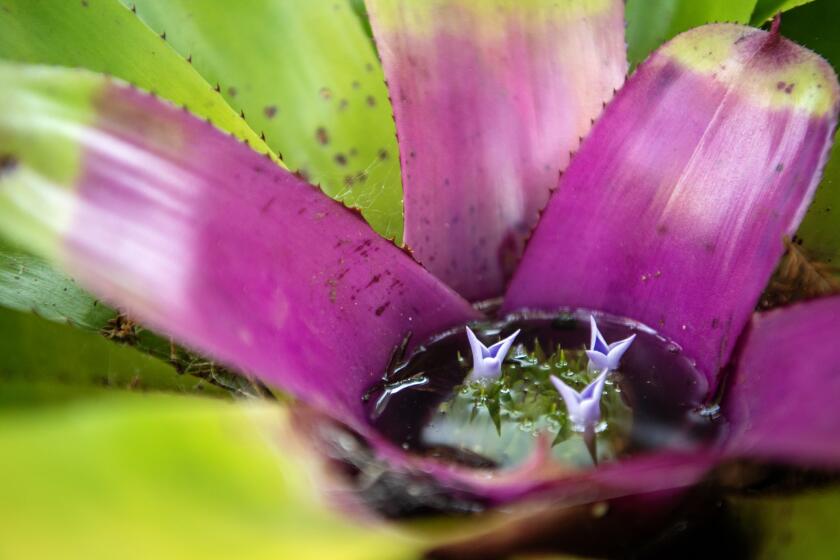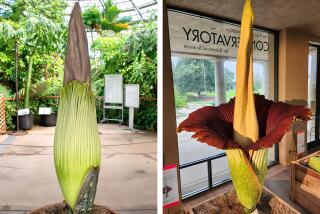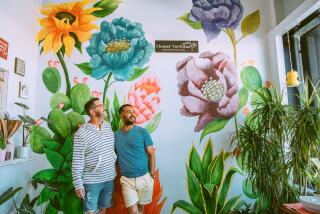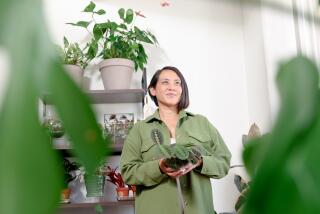How the weeping fig became the ‘It’ plant of the gardening world (again)
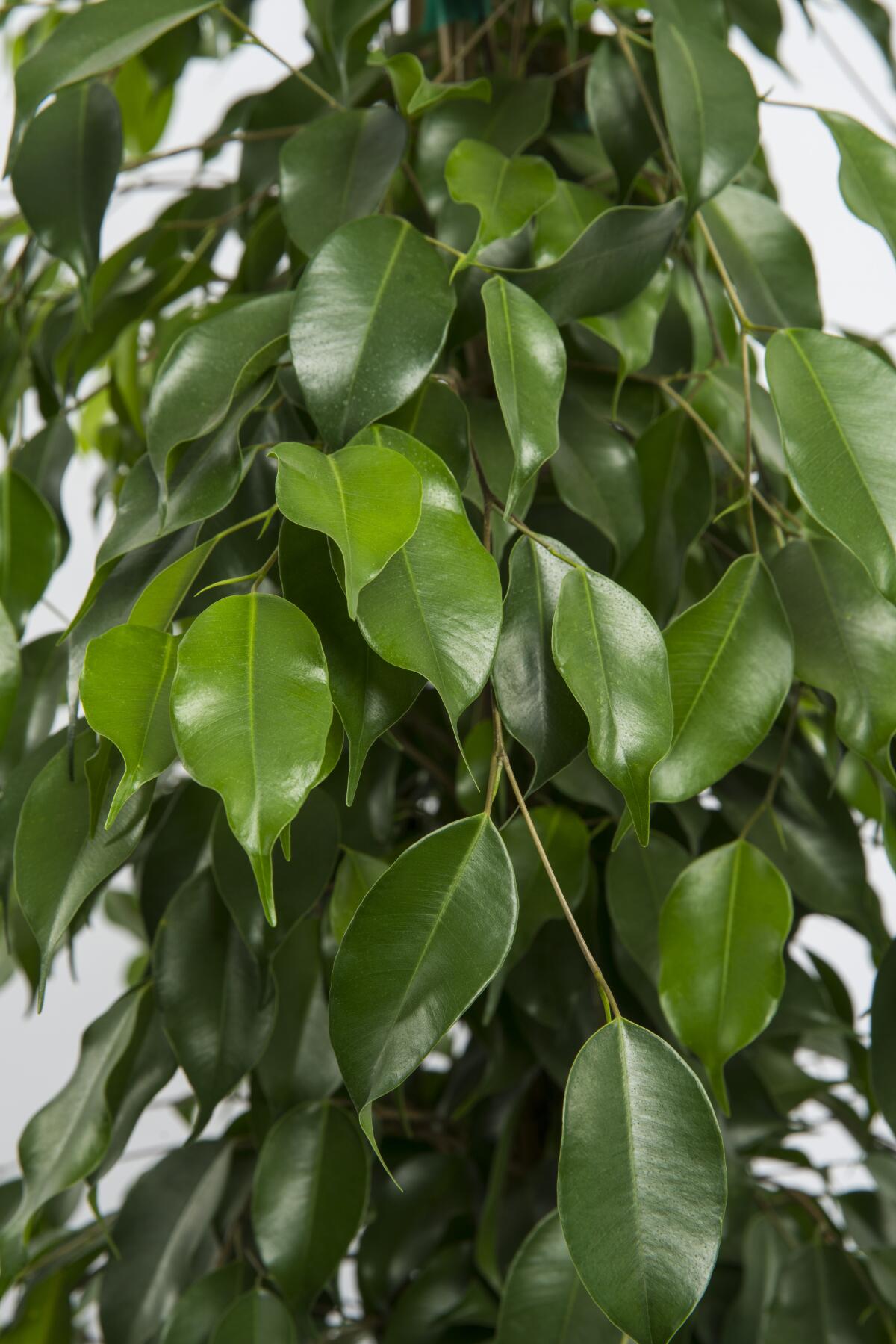
- Share via
For Mackenzie Roth, a 25-year-old film marketer based in Sherman Oaks, it began with a trip six months ago to the Home Depot in Glendale.
An avid home gardener, Roth has filled her apartment with a variety of house plants big and small. That day, though, she wasn’t particularly looking to add yet another plant to her collection; she was just dropping by the gardening department on a bit of whim. But the Ficus benjamina beckoned.
“I didn’t know a ton about it when I bought it,” said Roth of the plant, also known as the weeping fig, that she brought home that day. “It was about 4 feet tall, and it had this braided trunk that added a tree-like element I really wanted. I also love the shape of the leaves and the wispiness. It has a delicate look that none of my other plants have.”
Roth’s weeping fig is a classic example: braided trunk, delicately drooping branchlets, and a dense shock of glossy leaves about 2 inches long. The plant’s height is proportional to the volume of its container. Left unchecked in the wilds of its native Southeast Asia and Northern Australia, the weeping fig can easily reach 90 feet in height. But here in a small pot in an apartment in Sherman Oaks, Roth’s weeping fig will remain a manageable size in her bedroom, where she has placed it by a south-facing window away from any air-conditioning drafts.
While Roth may not have been familiar with the weeping fig, anyone who grew up in the ’70s or ’80s would immediately recognize this plant. During those decades, the weeping fig, often called a ficus plant, experienced an initial wave of popularity that landed it in rumpus rooms and dentist offices around the country. For a time, it seemed that everyone — or at least everyone’s parents — had a weeping fig in their home, and for that reason, it is a plant that continues to elicit nostalgia.
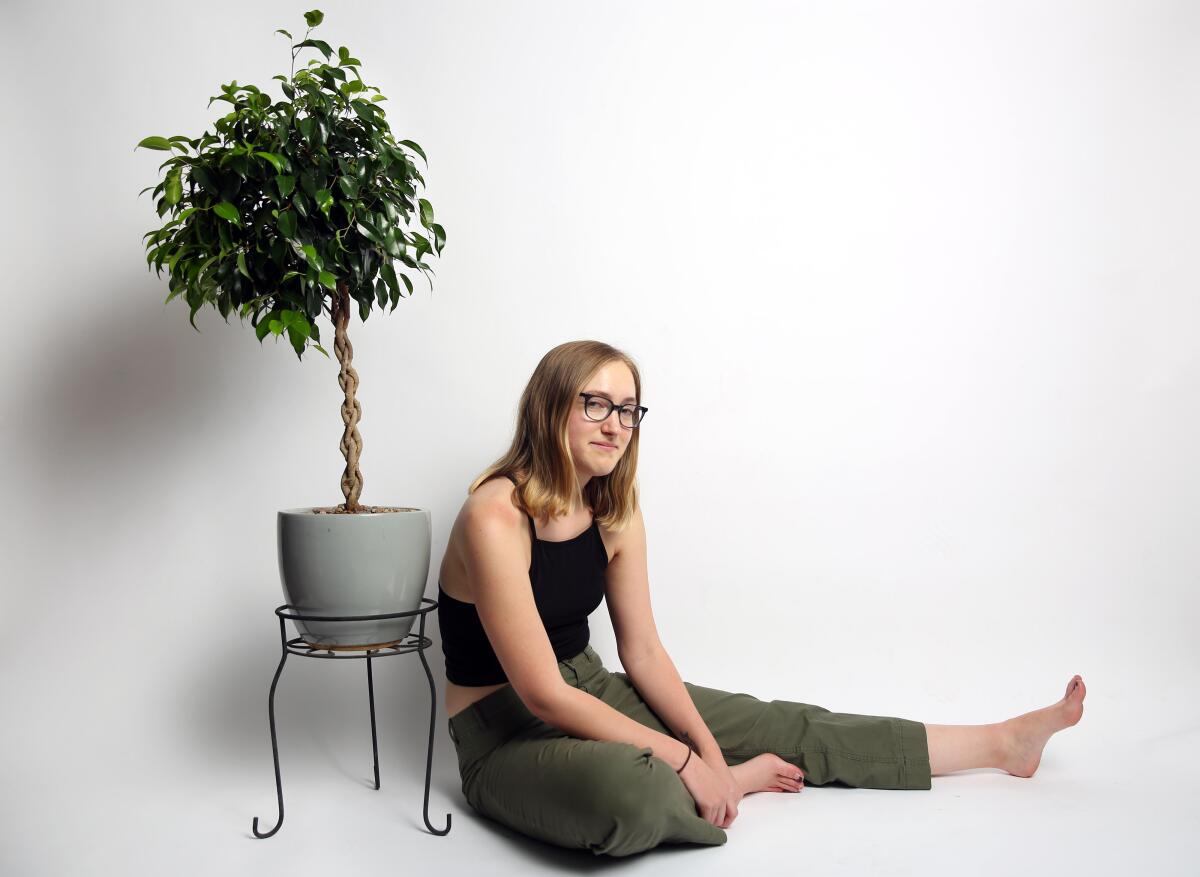
“Whenever I think of the benjamina, it reminds me of growing up in San Francisco, when I would go over to my friend’s house and we would watch “Pee-wee’s Playhouse” while sitting under this giant weeping fig hanging over us,” said Annette Gutierrez, co-owner of Potted, a home and garden store in Atwater Village. “It was enormous, and it would just sort of weep right over the couch.”
“I grew up with one in my home, and as many people have with plants, there’s this nostalgic connection to it,” said Eliza Blank, founder of the highly Instagrammed gardening store, the Sill, which opened in West Hollywood in February. “My mother still has it. It’s older than I am, actually. Literally I just associate it with my mom and the old guard of house plants.”
Greg Salmeri, co-owner of Rolling Greens, a nursery with three locations across L.A., said, “Honestly it’s the ’70s again. Weeping fig was huge in the ’70s but it’s back. We are selling a lot of them. It’s probably our third most popular plant right now.”
After 11 years and $6 million, Lotusland has finally reopened its Japanese garden.
According to Salmeri, the No. 1 seller at Rolling Greens is still very much the fiddle-leaf fig — the waxy, tropical-feeling plant that came to define 2010’s home decor. With its jumbo-sized leaves and spindly trunk, the fiddle-leaf fig, or Ficus lyrata, popped up in Céline boutiques everywhere, and was used in the offices of companies like Marimekko and mattress start-up Casper.
“It’s everywhere,” said interior designer Nicole Fuller of the fiddle-leaf fig’s ubiquity. “We’ve seen it all over. Love it, but it’s kind of just been killed to death.”
Fuller, who has offices in New York and L.A., recently installed a 7-foot-tall weeping fig in the office of Karyn Lovegrove, an art advisor in Hancock Park.
In a phone interview, Lovegrove said that because she is “in the business of tastemaking,” being ahead of the curve is crucial. “Nicole and I were having dinner just talking about the fact that the fiddle-leaf fig has been used a great deal and how we were yearning for our childhood. We thought it would be kind of amusing to use something very much out of fashion and bring it into fashion.”
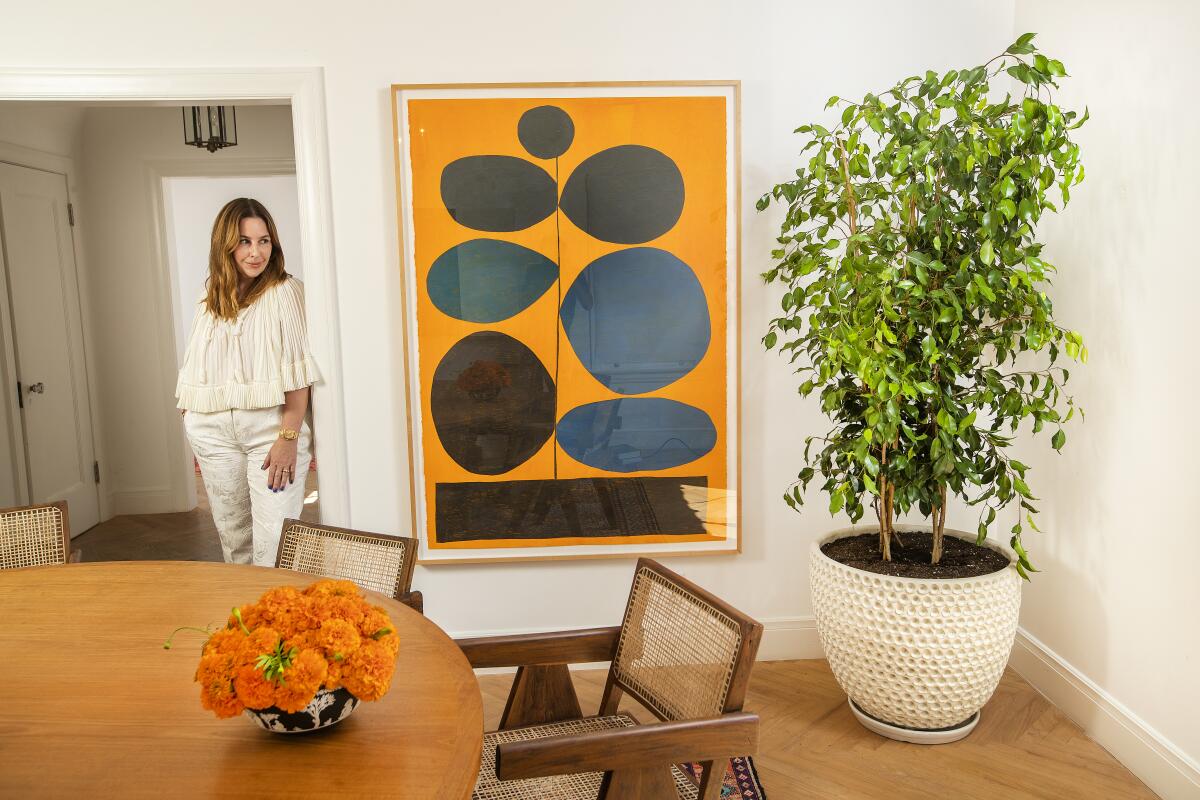
The interesting thing about weeping figs is not just that they are popping up in the well-heeled offices of art advisors as a tongue-in-cheek mise-en-scène — it’s how an incredibly ordinary ficus available at Home Depot for decades is suddenly fresh-feeling, even trend worthy.
Weeping figs are making their way through the gardening blogs circuit. An article in Elle Decor, titled “The Best Plant To Buy For Every Room in Your Home,” recommended the weeping fig as perfect for the bedroom. The Instagram hashtag “#ficusbenjamina” has nearly 12,000 hits. And in our interviews with them, Guttierez, Blank and Salmeri all referenced the seminal 1989 NASA study “Interior Landscape Plans for Indoor Air Pollution Abatement,” which lauded the Ficus benjamina for its ability to remove toxins like benzene and trichloroethylene from the air — a connection to wellness that feels particularly apropos to home decor right now. (One drawback: the leaves of the weeping fig can be toxic to dogs and cats if ingested.)
A landscape architect creates a tranquil backyard getaway in Westwood by applying Japanese garden concepts to stimulate the senses and draw attention to the ephemeral beauty of nature.
Mickey Hargitay, who owns an eponymous Hollywood plant shop (where Lovegrove got her weeping fig), remembers the first time weeping figs came around. “The interesting thing is that there’s new varieties they’ve come up with since the ’70s, when there was really just the one benjamina,” he said. “Now there are darker-leaf ones, ones with ripples in the leaves, braided trunks, all sorts of offshoots and variations.”
While all ficus species are famously temperamental — shedding leaves with the slightest hint of a breeze or overwatering or too little sunlight — the weeping fig does hold an advantage over its fiddle-leaf cousin: It has more leaves. Said Gutierrez: “Fiddle-leaf figs, one leaf falls off and you freak out — they’re the size of your hand, they’re huge. If a benjamina defoliates somewhat, you aren’t left with this big bald spot on your tree. It isn’t as frightening as when a lyrata loses a leaf.”
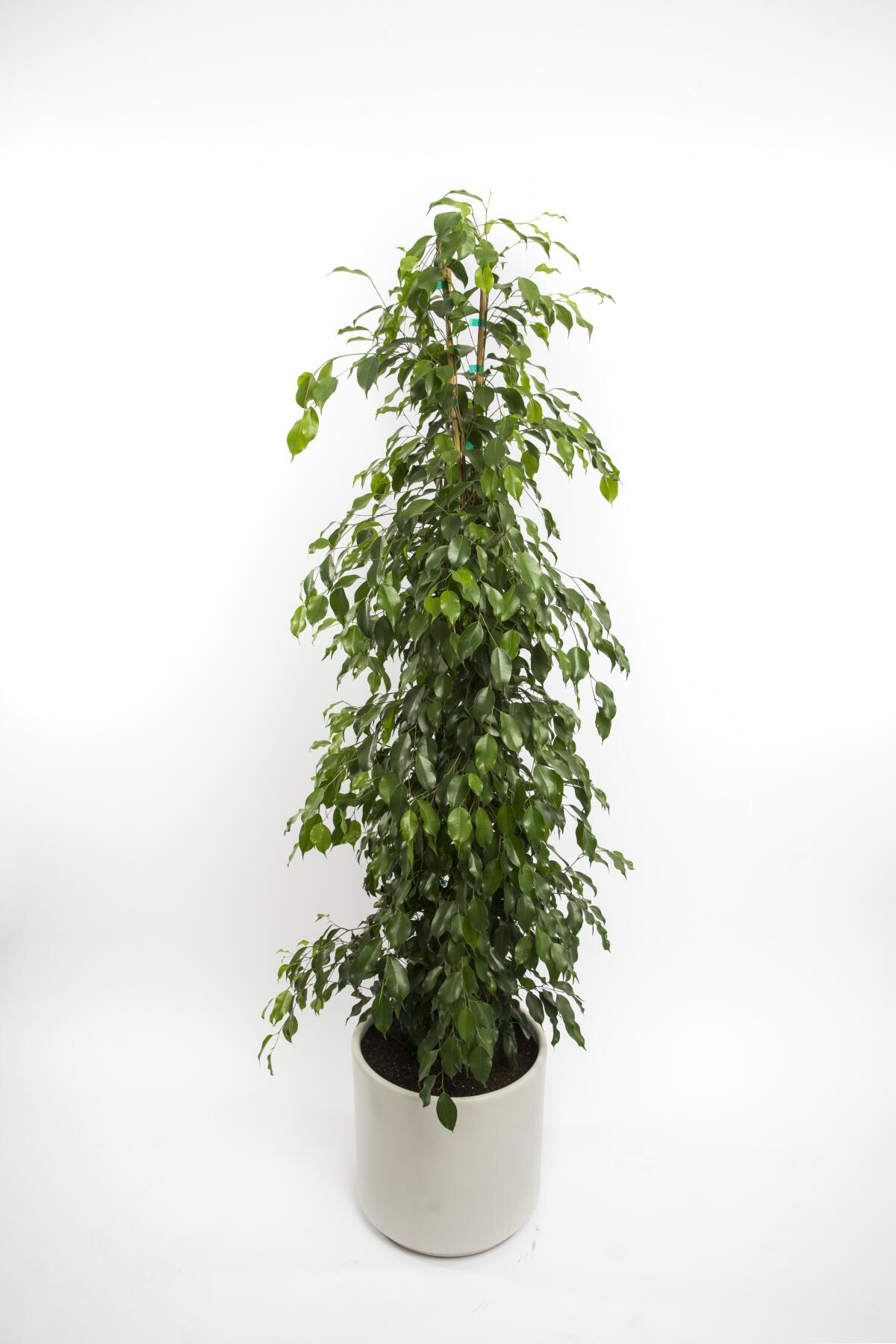
The weeping fig’s versatility makes it a more adaptable design element than the fiddle-leaf fig. It isn’t as overtly contemporary or tropical. “The weeping fig can slip into the background,” said Salmeri. “The fiddle-leaf you notice right away.”
If the fiddle-leaf fig was about buying into a trend and conforming to a certain look, the weeping fig is about seamlessly integrating plants into the spaces of your life.
That’s why a benjamina can work in so many different spaces, like an art advisor’s home in Hancock Park. Or a millennial apartment in Sherman Oaks. Or an elegant estate in Sonoma, where designer duo Austin Carrier and Alex Mutter-Rottmayer of the popular instagram “@hommeboys” account just installed one. Or in the home of Danni Fathman, a yoga instructor in Escondido who recently purchased a weeping fig for her pet chameleon Pasquale to climb on.
“Weeping fig has always been sentimental for me,” said Fathman. “Growing up in San Diego, my parents used one as a Christmas tree for multiple years. It’s huge now, and they’ve planted it in their backyard.”
Roth pointed out that the un-trendiness of the weeping fig has more practical considerations as well. “I bought my tall, braided trunk weeping fig for about $25. They’re a lot less expensive than the fiddle-leaf fig, which are really overpriced in L.A. You can get a tiny fiddle-leaf fig for $40, which doesn’t really seem worth it to me.”
More to Read
Sign up for The Wild
We’ll help you find the best places to hike, bike and run, as well as the perfect silent spots for meditation and yoga.
You may occasionally receive promotional content from the Los Angeles Times.
